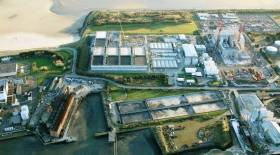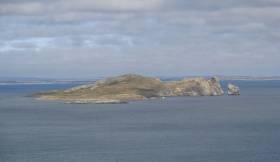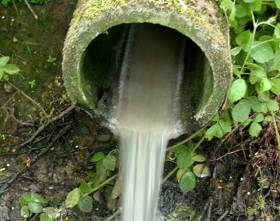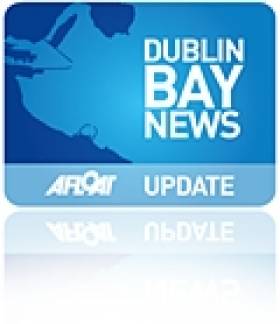Displaying items by tag: Wastewater
Planning Hearing On Clonshaugh Wastewater Plant Gets Under Way
Planners are from today set to review proposals for a controversial €500 million wastewater treatment scheme in North Dublin, as The Irish Times reports.
Clonshaugh near Dublin Airport was chosen in June 2013 as the site for the sewage ‘super plant’ before Irish Water took over the Greater Dublin Drainage project from Fingal County Council last year.
The new plant — second only to the Ringsend wastewater facility in scope — would be connected to a new orbital sewer to Blanchardstown, and an outfall pipe to eject treated wastewater in the sea north of Ireland’s Eye.
Plans for the new sewage processing plant have faced strong local opposition, both from residents adjacent to the Clonshaugh site and connected works and marine professionals concerned about potential environmental risks.
Last October, Howth-based ferryman Ken Doyle expressed his fears of the knock-on effect on fish stocks from any accidental contamination of the local waters from the outfall pipe.
The planning hearing began at The Gresham hotel in Dublin this morning, and The Irish Times has more on the story HERE.
EPA Investigates Wastewater Discharge In River Liffey
This past weekend’s discharge of wastewater in the River Liffey from the Irish Water treatment plant in Ringsend is being investigated by the Environmental Protection Agency.
As RTÉ News reports, failure of a processing tank at the locally controversial site led to the overflow, which Irish Water confirmed was from an outfall 1km from the plant in the Lower Liffey Estuary in Dublin Bay, around 9am on Saturday (23 February).
Irish Water says the discharge of ‘activated sludge’ — which “does not pose the same risk to public health or the environment as a raw sewage discharge would” — lasted for around 20 minutes.
But drone images captured on Saturday evening showed the persistence and extent of the pollution incident beside the Great South Wall.
The Ringsend wastewater treatment plant is reportedly running at 20% above capacity as it treats two-fifths of all wastewater in Ireland.
As such, its standard discharge “does not comply with the Urban Wastewater Treatment requirements”, according to an Irish Water statement which also confirmed that the EPA conducted an audit of the affected site yesterday (Tuesday 26 February).
#MarineWildlife - A Howth-based ferryman fears for marine wildlife on and around Ireland’s Eye when a planned sewage outfall pipe begins discharging wastewater in the area.
Ken Doyle of Ireland’s Eye Ferries tells Dublin Live that any accidental contamination of the waters from the pipeline, from Clonshaugh to a mile off the small island immediately north of Howth, could have a disastrous knock-on effect on fish stocks — an issue both for sea anglers and local bird and seal colonies.
Five years ago, Clonshaugh in North Co Dublin was chosen as the location for the capital’s wastewater treatment ‘super plant’.
The scheme will connect a 26km orbital sewer through counties Dublin, Kildare and Meath with an outfall pipeline ejecting waste off Ireland’s Eye.
Doyle noted that when the outflow of raw sewage at Howth Head was ended with the opening of the Ringsend treatment plant, improvements in water quality meant “the bird population increased hugely and it’s all positive but I wouldn’t like it to go back to like it was.”
He adds that he is not opposed to the wastewater scheme in principle — only that he and other local residents and businesses want assurances that the plant will not have any negative impact on the environment.
Cork Cement Company Prosecuted Over River Pollution
#Pollution - Inland Fisheries Ireland (IFI) has prosecuted cement company Keohane Readymix Limited over a discharge into the Argideen River at Fourcuil in Clonakilty, Co Cork on 9 March last.
At a sitting of Clonakilty District Court on Tuesday 18 October, Keohane Readymix Limited pleaded guilty to a breach of Sections 171(1) and 173(1)(c) of the Fisheries (Consolidation) Act 1959. The company were ordered to pay over €10,000 by Judge James McNulty.
The court heard how a breach in a settlement pond at a sand and gravel washing site on Wednesday 9 March caused a significant overflow of wastewater carrying suspended solids into the Argideen River. IFI officers investigated the incident and identified the source of the pollution.
Judge McNulty imposed a fine of €2,500 in respect of the first count to Keohane Readymix and awarded costs and legal expenses of €2,598 to IFI.
In relation to the charge under Section 173(1)(c), the defendant agreed to Judge Mc Nulty’s suggestion of a €5,000 contribution to the Court Charity Fund.
Sean Long, director of the South West River Basin District at IFI, said: “We would urge landowners and businesses to remain vigilant and to employ robust management systems to prevent avoidable incidents which can have a serious impact on our wild fish and their natural habitat.
“Inland Fisheries Ireland is working to protect, conserve and develop our natural fisheries resource which is of significant recreational and economic value to communities in Cork and across the country.”
Inland Fisheries Ireland has a confidential hotline number to enable members of the public to report incidents at 1890 34 74 24 or 1890 FISH 24. This phone line is designed to encourage the reporting of incidents of illegal fishing, water pollution and invasive species.
Irish Water Convicted on Pollution Charges
At a sitting of Cavan District Court on 21st April 2016, Judge Denis McLaughlin convicted Irish Water in relation to a pollution incident arising from the wastewater treatment plant at Ballinagh, Co. Cavan.
Senior fisheries environmental officer Ailish Keane from Inland Fisheries Ireland (IFI) gave evidence that she had written to Irish Water on several occasions prior to the incident about failings at the treatment plant, but the company had not acted. On 20th June 2015, IFI staff noticed effluent entering the Ballinagh River and Ms Keane attended the scene and took samples. The samples showed very serious pollution of the river coming from the treatment plant, with levels of some pollutants almost 600 times higher than upstream.
In particular, the level of ammonia observed downstream was 17.9 milligrams per litre – 597 times the level of 0.03 milligrams per litre measured upstream, a level recognised as clean salmonid water. The level of suspended solids was 122 milligrams per litre, approximately 3.5 times higher than the plant’s allowed emission limit. The biological oxygen demand, a measure of bacterial growth in the water, was measured at 223.8 milligrams per litre downstream which is 45 times higher than what is expected in clean unpolluted water, and over 100 times higher than the level of two milligrams per litre observed upstream.
Judge Denis McLaughlin refused to consider a plea by defence counsel to consider a donation to charity, insisting that the delay in rectifying the issue by Irish Water, and the serious level of pollution, merited a conviction. He convicted and fined the company €2,500 in addition to costs amounting to €3,917.43.
Commenting on the case, Dr Ciaran Byrne, CEO of Inland Fisheries Ireland, said: “Protection of fish stocks and water quality is vital to maintaining an extremely valuable natural resource for the benefit of local and tourist anglers alike. Inland Fisheries Ireland is committed to protecting the most vital component of good habitat to fish – high water quality. Our staff will continue to monitor and enforce water quality legislation in order to maintain healthy fish stocks.”
Inland Fisheries Ireland (IFI) has a confidential hotline number to enable members of the general public to report incidents - 1890 34 74 24 or 1890 FISH 24. This phone line is designed to encourage the reporting of incidents of illegal fishing, water pollution and invasive species.
Minister Turns Sod On New Cork Harbour Wastewater Treatment Plant
#CorkHarbour - Environment Minister Alan Kelly has turned the sod on a new €91 million wastewater treatment facility for Cork Harbour that's set to curb the release of untreated sewage into the water supply.
As Irish Building reports, the new Irish Water plant at Shanbally forms part of the Cork Lower Harbour Main Drainage Project and aims to end the practice of releasing untreated wastewater into the harbour from locations such as Cobh, Carrigaline and Crosshaven, Passage West, Monkstown and Ringaskiddy - previously identified as pollution blackspots in dire need of secondary treatment facilities.
EPS and Sisk have been awarded the contract to design and build the Shanbally plant, which will have capacity equivalent to a population of 65,000. EPS will operate the facility for up to nine years on behalf of Irish Water upon completion in the second quarter in 2017.
In addition, Shanbally will be only the third such project in Ireland and the UK to employ Nereda biomass technology for sustainable wastewater treatment, following recent upgrades to a plant in Clonakilty and a new facility being completed in Carrigtwohill.
Dublin Bay Oil, Gas, Coal...and Waste-Water!
The work is part of a Dublin City Council project to evaluate an extension at the Ringsend plant where treated water will be released into the bay. The council are conducting detailed feasibility studies which will be examined for an Environmental Impact Assessment.
To date the project has involved two other rigs, the Aran 250 and the larger Excalibur which remains in the bay. The barges will be towed to 20 pre-determined bore-hole locations in the bay where the jack-up rig barges operate 'legs' to sit on the seabed which enables a steady working platform. The rigs are operating on a continuous basis in an area covering most of Dublin Bay and close to the Burford Bank on the eastern fringes.
In addition a buoy will be positioned 300-metres of the barge during drill operations, which is expected to take approximately one week for each drill. For information on the location of the bore-holes, they can viewed from the Dublin Port website by clicking HERE The project is expected to be completed in late Spring.
Several support craft are engaged in the project that recently included the Seabed Worker, a 3,923 gross tonnes Norwegian anchor-handling tug supply vessel (AHTS) the tugs Multratug 7, MTS Valiant and Trojan and the RIB-craft sisters, Brian Boru and James Joyce which are on standby duties. Like the Trojan, the 12-seater RIBS are based at the Poolbeg Yacht Club Marina where in the tourist season the craft provide excursions in Dublin Bay for Sea Safari Tours. In October the project also required the services of the yellow-hulled catamaran, Xplorer to carry out a bathymetric survey of Dublin Bay. The larger tugs and rigs are based opposite in Alexandra Basin / Ocean Pier.
The largest drill-rig working to date on the project, the Excalibur arrived under the tow of the Multratug 7 on a misty morning on Christmas Day. Due to the weather conditions the red-hulled craft slipped quietly into the port. Several days later the imposing looking craft re-emerged with its six-towering jack-up 'sea-legs' that jutted skywards into an otherwise horizontal expanse of Dublin Bay.
The sight of the rig has presented many onlookers to mistakenly believe the drilling was for oil!...Not so but the assumption is not surprising given the reports last year of an oil-field discovery named the Dalkey Island Prospect. The name for the oil-field was referred to Dalkey, as the coastal suburb on the southern shores is the nearest landfall to the exploratory well sites at the Kish Bank Basin.
In fact this kind of exploratory activity was again to confuse residents throughout the bay when the drill-ship, Fugro Synergy was offshore at the Kish Bank between December 2009 and early Spring of 2010. Though on this occasion the search was not for oil but coal!
During this period the 5,200 tonnes vessel equipped with a drill-tower, seemed to be a near permanent feature on the horizon. A series of drill-wells up to 3,500-metres were conducted when the 2009 built ship was contracted to Irish based VP Power Ltd, to determine the commercial viability of extracting coal from the sea for generating electricity. The Underground Coal Gasification (UCG) project is a process where coal is heated in underwater rock reservoirs to extract gas, essentially converting gas-from-coal energy. Otherwise this method is commonly referred to as a 'clean' technology.
In addition to last year's search for deposits of large coal seams under the seabed, there was reports of a significant natural resource in the form of oil!... when several exploratory blocks again in the Kish Bank Basin were surveyed. The company behind this venture, Provident Resources, another Irish based exploration company, conducted initial oil surveys using air-born craft and as such no actual drill-based ships or rigs were used. Though should any oil flow, such an operation would be required.
Incidentally the Excalibur is designed also to perform offshore wind turbine installation work and is equipped with a 250-ton crane to hoist the wind-farm components. The vessel is operated by Fugro Seacore, a subsidiary of the Dutch parent company, Fugro, which also managed the drill-ship Fugro Synergy.





























































